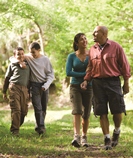

By: C. A.; Bopp Lovelady, M. J.; Colleran, H. L.; Mackie, H. K.; Wideman, L.
Publication Name: Med Sci Sports Exerc
Year: 2009
PURPOSE: During lactation, women transfer approximately 200 mg of calcium per day to breast milk. For 6 months, this is equivalent to 3%-9% of bone mineral density (BMD) loss at trabecular-rich sites. Bone mass usually returns to prepregnancy levels with cessation of lactation but not in all women. Therefore, the purpose of this study was to determine whether exercise slows bone loss from 4 to 20 wk postpartum (PP). METHODS: At 4 wk PP, women were randomized to either an exercise group [EG, n = 10, weight bearing aerobic exercise (3 d.wk(-1), 45 min.d(-1)) and 3 d.wk(-1) of resistance exercise] or a control group (CG, n = 10, no exercise) for 16 wk. Body composition and BMD were measured by dual-energy x-ray absorptiometry at the lumbar spine (LS), hip, and total body. Maximal strength and predicted maximal oxygen consumption (VO2max) were determined by 1-repetition maximum and submaximal treadmill test, respectively. Repeated-measures ANOVA was used to test for time and time by group differences. RESULTS: EG lost significantly less LS BMD than CG (-4.8 +/- 0.6% vs -7.0 +/- 0.3%, P < 0.01). There were no significant differences in total body and hip BMD. Both groups lost fat mass (EG = -2.9 +/- 0.7 kg, CG = -1.8 +/- 0.4 kg); however, EG lost less lean body mass (-0.7 +/- 0.3 vs -1.6 +/- 0.3 kg, P = 0.05). Maximal strength increased by 34% to 221% for all exercises in EG, whereas CG changed -5.7% to 12%. Predicted VO2max increased in both groups (EG = 11.4 +/- 2.0, CG = 6.9 +/- 1.7%). CONCLUSIONS: These results suggest that resistance and aerobic exercise may slow bone loss during lactation.
Click purchase to access this publication. Many may be available at no cost.